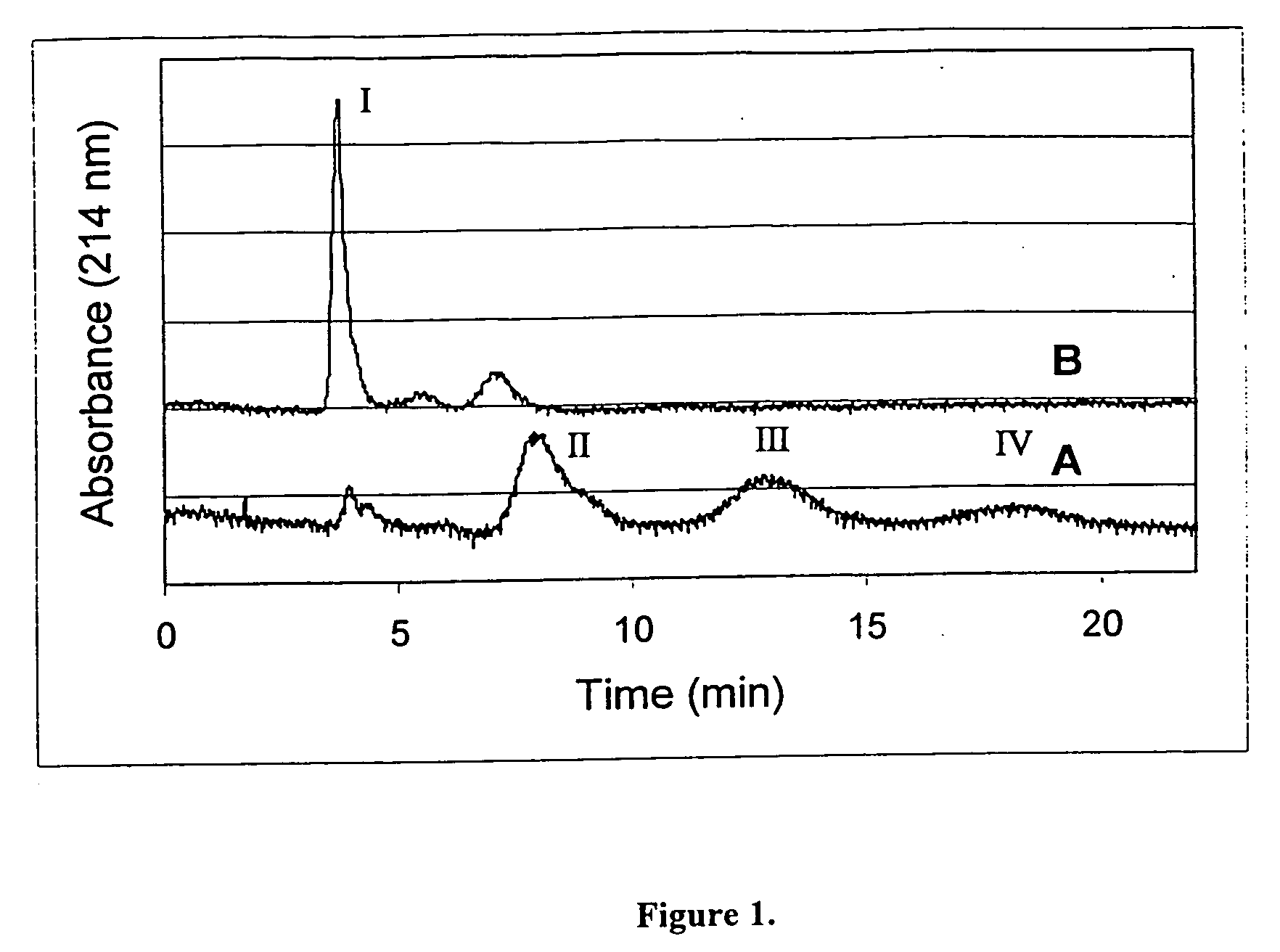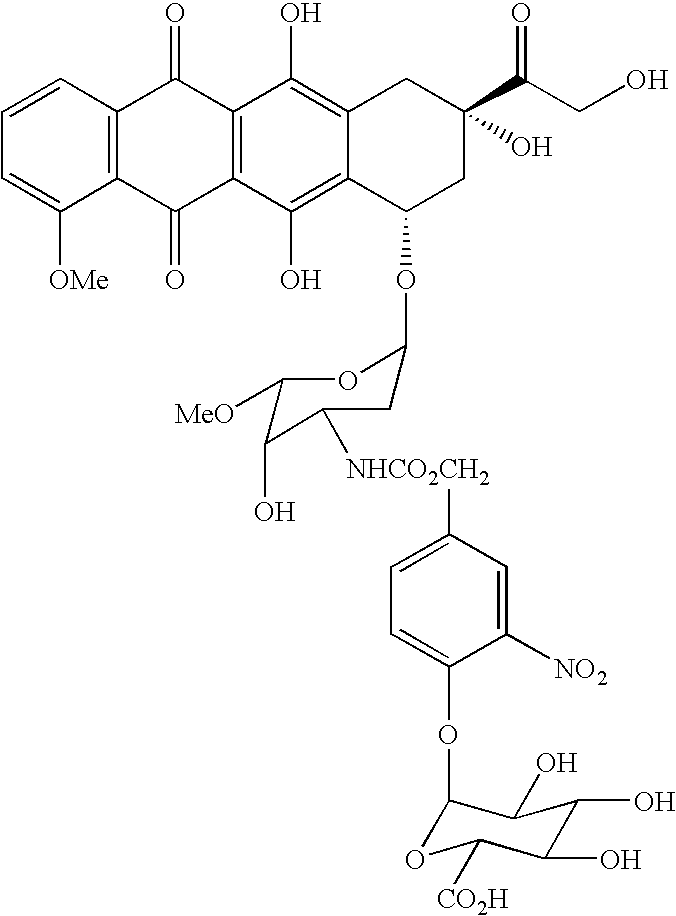Hydrolytically degradable carbamate derivatives of poly(ethylene glycol)
a technology of hydrolysis and carbamate, which is applied in the direction of cardiovascular disorders, drug compositions, and aerosol delivery, etc., can solve the problems of not all linkages are readily degradable and useful in prodrug use, limit their practical application, and are not amenable to imine prodrug approach. , to achieve the effect of rapid releas
- Summary
- Abstract
- Description
- Claims
- Application Information
AI Technical Summary
Benefits of technology
Problems solved by technology
Method used
Image
Examples
example 1
[0069] Synthesis of N-mPEG Benzamide-m-succinimidyl Carbonate (1)
[0070] mPEG amine 5000 (1.5 g, 0.3 mmole), 3-hydroxybenzoic acid (44 mg, 0.315 mmole) and dicyclohexylcarbodiimide (DCC, 84 mg) were dissolved in 20 ml of anhydrous THF. The solution was stirred at room temperature overnight. The solvent was condensed to half on a rotary evaporator and the residue was precipitated into 150 ml of ethyl ether. The precipitate was collected by filtration and dried in vacuo. Yield 1.5 g (100%). 1H NMR(DMSO-d6): δ 3.5 (br m, PEG), 6.90 (m,aromatic), 7.22 (m, aromatic), 8.37 (t, PEG-NHCO—), 9.62 (s, —C6H6—OH).
[0071] The above product (1 gram) and disuccinimidyl carbonate (DSC, 200 mg) were dissolved in 8 ml of acetonitrile. To the solution was added 200 ul of pyridine. The solution was stirred under nitrogen overnight and the solvent was removed under reduced pressure. The resulting solid was redissolved in 10 ml of dry chloroform and the insoluble solid was removed by filtration. The sol...
example 2
[0072] Synthesis of N-mPEG-benzamide-p-succinimidyl Carbonate (2)
[0073] mPEG amine 5000 (3 g, 0.6 mmole), 4-hydroxybenzoic acid (87 mg, 0.62 mmole) and dicyclohexylcarbodiimide (DCC, 160 mg) were dissolved in 20 ml anhydrous THF. The solution was stirred at room temperature overnight. The solvent was condensed to half on a rotary evaporator and the residue was precipitated into 150 ml of ethyl ether. The precipitate was collected by filtration and dried in vacuo. Yield 3 g (100%). 1H NMR(DMSO-d6): δ 3.5 (br m, PEG), 6.78 (d,aromatic), 7.70 (d, aromatic), 8.23 (t, PEG-NHCO—), 9.94 (s, —C6H6—OH).
[0074] The above product (1.5 gram) and disuccinimidyl carbonate (DSC, 300 mg) were dissolved in 12 ml of acetonitrile. To the solution was added 300 ul of pyridine. The solution was stirred under nitrogen overnight and the solvent was removed under reduced pressure. The resulting solid was redissolved in 10 ml of dry chloroform and the insoluble solid was removed by filtration. The solutio...
example 3
[0075] Synthesis of MPEG Phenyl ether-p-succinimidyl Carbonate (3)
[0076] mPEG mesylate 5000 (5 g, 1 mmole) in 60 ml of toluene was azeotropically distilled under nitrogen. After two hours, the solution was cooled to room temperature. 4-benzyloxyphenol (0.44 g, 2.2 mmole) was added to a mixture of 0.46 ml of sodium methoxide (2 mmole, 25% in methanol) and 25 ml of dry methanol. The mixture was slowly stirred under nitrogen for 20 minutes. Methanol was then gradually distilled off until about 5 ml of solution was left. 50 ml of dry toluene was added and the solution was distilled under nitrogen. The azeotropic distillation was not stopped until all methanol was removed. The mixture was cooled to room temperature. The freshly azeotropically dried mPEG mesylate from the previous step was added and the mixture was refluxed under nitrogen overnight. The reaction mixture was cooled to room temperature, toluene was distilled off, and methylene chloride was added. The solid was removed by ...
PUM
| Property | Measurement | Unit |
|---|---|---|
| molecular weight | aaaaa | aaaaa |
| molecular weight | aaaaa | aaaaa |
| pH | aaaaa | aaaaa |
Abstract
Description
Claims
Application Information
 Login to View More
Login to View More - R&D
- Intellectual Property
- Life Sciences
- Materials
- Tech Scout
- Unparalleled Data Quality
- Higher Quality Content
- 60% Fewer Hallucinations
Browse by: Latest US Patents, China's latest patents, Technical Efficacy Thesaurus, Application Domain, Technology Topic, Popular Technical Reports.
© 2025 PatSnap. All rights reserved.Legal|Privacy policy|Modern Slavery Act Transparency Statement|Sitemap|About US| Contact US: help@patsnap.com



